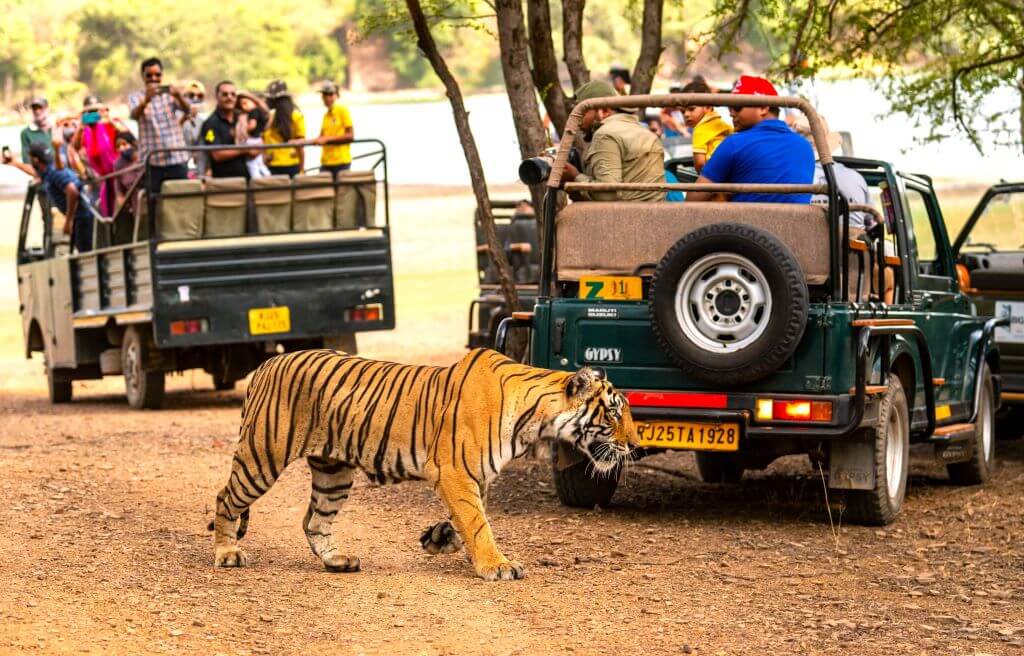Ranthambore National Park stands among India’s finest tiger reserves, renowned for its thriving population of Royal Bengal Tigers along with a diverse range of animals and bird species. Spanning an area of 1,334 sq. km (515 sq. mi), the park is beautifully flanked by the Banas River in the north and the Chambal River in the south. Located in the Sawai Madhopur district of Rajasthan, Ranthambore enjoys excellent connectivity with major cities like Jaipur, making it convenient for tourists to access its popular safari zones.
As one of the largest national parks in North India, Ranthambore is a treasure trove of rich flora and fauna, including several endangered species. For those eager to witness Bengal tigers in their natural habitat, the park offers thrilling jungle safari experiences that guarantee unforgettable encounters with wildlife.
Blessed with breathtaking landscapes, Ranthambore boasts a mix of lush greenery, rugged hills, ravines, lakes, waterholes, and arid plains, creating a dramatic setting for photography and videography. With its scenic charm and abundant wildlife, it is a must-visit destination for nature lovers, adventure seekers, and wildlife enthusiasts alike.
Best Tiger Safari Zone in Ranthambore
Ranthambore National Park is divided into 10 safari zones to ensure smooth management of tourism activities and to evenly distribute visitors across the forest. This system helps prevent overcrowding in tiger-prone areas and protects the natural habitat of wildlife.
At the entry gate, zones are allotted to safari vehicles by forest officials through a computerized random system. Visitors cannot choose their preferred zone, and no external interference is possible in this process. Both jeeps and canters follow the same designated routes, offering equal opportunities for wildlife sightings.
Each safari zone has its own unique charm, featuring a mix of core and buffer areas with diverse landscapes and rich wildlife. Every safari takes you into the core area of the assigned zone, where the chances of spotting a tiger are nearly the same across zones. Once allotted, safari vehicles must remain within their designated zone but are free to explore the entire network of routes inside it.
Guide to the Safari Zones of Ranthambore
Ranthambore National Park is divided into 10 safari zones, each offering a unique experience of wildlife and landscapes. However, when it comes to the best zones for tiger safaris, five zones stand out — Zones 1, 2, 3, 4, and 5. These zones are considered prime tiger territories, with frequent sightings and diverse habitats that make every safari thrilling. Each of them has its own distinct charm, ensuring that every visitor enjoys a different yet unforgettable wildlife adventure.
Tourists can also enjoy exciting wildlife encounters in Zones 6 to 10, which offer ample opportunities for sightings. Among the prime zones, Zone 2 holds special importance as it features several waterholes and an abundance of wildlife. This zone is also a popular spot for leopard sightings, making it a favorite among visitors.
Moving on to Zone 6 (Kundal), the experience becomes quite different. Known for its scenic landscapes, this zone is a paradise for bird watchers. It is one of the best places in Ranthambore to spot the red-headed vulture, an endangered species. With its unique charm, Zone 6 stands apart from the rest, offering a refreshing mix of natural beauty and avian diversity.
With that said, let’s explore the top safari zones in Ranthambore that promise the best chances of spotting tigers and other fascinating wildlife.
Zone 1 – Territory of Iconic Tigers
Zone 1 of Ranthambore National Park is home to some of the most renowned Bengal tigers, including Ustad (T-24), Noor (T-39), and Sultan (T-72). Entry and exit to this zone is through the Singh Dwar gate.
This zone is particularly popular among tourists due to its high probability of tiger sightings. Key spots within Zone 1 where tigers are frequently spotted include Sultanpur, Amreshwar Dang, Peela Pani, Tuti Ka Nalla, and Gada Dub. With its rich wildlife presence and scenic terrain, Zone 1 remains a favorite for wildlife enthusiasts and photographers.
Zone 2 – A Prime Tiger Territory
Zone 2 is regarded as one of the best safari zones in Ranthambore due to its high frequency of tiger sightings. The presence of numerous waterholes attracts big cats, making this zone a hotspot for tourists.
Some of the key locations within this zone include Jogi Mahal, Nal Ghati, Phuta Kot, Phuta Bandha, Jhalra, and Lahpur Tiraha. Zone 2 is home to several legendary tigers such as Ustad (T-24), Noor (T-39), Sultan (T-72), Krishna (T-19), and Jhumru (T-20).
Apart from Bengal tigers, visitors may also encounter leopards here, adding to the thrill of the safari. With its abundant wildlife and scenic beauty, Zone 2 is truly a favorite among safari-goers.
Zone 3 – The Famous Padam Talab & Tiger Territory
Zone 3 is considered one of the prime safari zones in Ranthambore, known for its scenic beauty and frequent tiger sightings. This zone is home to Sitara (T-28), Krishna (T-19), and their cubs, making it an exciting place to witness tiger families in their natural habitat.
The highlight of this zone is the Padam Talab (Padam Lake), one of the most iconic lakes of the park, which often attracts tigers and other wildlife. Other notable spots within this zone include the Raj Bagh Ruins, Jogi Mahal, High Point, and Mandook. With its combination of history, natural beauty, and big cat sightings, Zone 3 is a top choice for wildlife enthusiasts and photographers.
Zone 4 – Legacy of Tigress Machli
Zone 4 holds a special place in the history of Ranthambore as the territory of the legendary tigress Machli, often called the “Queen of Ranthambore.” Even after her passing, this zone continues to be one of the most sought-after areas due to its thriving tiger population.
Today, Zone 4 is home to several famous tigers including T-19, T-25, T-28, T-41, T-64, and T-75. Popular locations within this zone where tiger sightings are frequently reported include Malik Talab, Singh Dwar, Lakkar Da, Lambi, Adidaant, and Tamakhan.
With its strong tiger presence and rich natural beauty, Zone 4 remains a favorite among wildlife enthusiasts and photographers.
Zone 5 – Popular Tiger Spotting Trails
Zone 5 is another prime safari zone in Ranthambore, offering excellent chances of tiger sightings. Some of the famous tigers frequently spotted here include T-17, T-25, T-28, T-74, and T-75.
This zone shares the same entry gate as Zone 4 (Singh Dwar) and has several overlapping areas, yet it maintains its own charm with distinctive landscapes and wildlife movement. Key locations within Zone 5 known for frequent tiger activity include Kachida Valley, Anantapur, Jokha, Bagda, and Dhakda.
With its star tiger residents and diverse terrains, Zone 5 continues to be a favorite among visitors looking for thrilling jungle encounters.
Zone 6 – Open Grasslands & Birdwatcher’s Paradise
Zone 6 is well-known for the presence of Noor (T-39) and her cubs, who are frequently sighted by visitors. Other tigers such as T-8, T-34, and T-57 are occasionally spotted here as well. Though this zone is adjacent to Zone 1, the entry gates are located on opposite sides of the park.
The landscape of Zone 6 is quite distinctive, featuring vast open grasslands backed by rugged hills, offering a unique safari experience. Apart from tigers, this zone is a delight for bird watchers, as it is home to several rare species including the endangered Red-Headed Vulture.
Notable points within Zone 6 for higher chances of tiger sightings include Palli Darwaza, Kala Pani, Patwa Ki Baori, Soleshwar, Khabli, and Saran Ka Pattha. With its blend of big cats, rare birds, and stunning scenery, Zone 6 offers a safari experience unlike any other.
Zone 7 – A Lesser-Known Tiger Territory
Zone 7 is primarily known as the territory of T-8 and T-34, though tiger sightings here are less frequent compared to other zones. While it offers fewer prime tiger-spotting points, the zone provides good opportunities to observe a variety of other wildlife species.
Key locations within Zone 7 where tigers are occasionally sighted include Jamoda, Chidikho, Kushalipura, and Rajbagh Naka. Though not as popular as some of the core zones, Zone 7 appeals to those who enjoy exploring quieter trails and discovering the park’s diverse fauna beyond tigers.
Zone 8 – Twin to Zone 7
Zone 8 shares a similar landscape and wildlife movement patterns with Zone 7, and is also part of the territory of T-8 and T-34. While tiger sightings here are occasional, the zone offers a peaceful safari experience with fewer crowds.
Notable locations within Zone 8 that increase the chances of spotting a tiger include Balas, Kali Bhat, Neemli Dang, Mahakho, and Kherai. With its rugged terrain and serene setting, Zone 8 provides a quieter wildlife adventure for those looking to explore beyond the popular safari trails.
Zone 9 – Along the Chakal River
Zone 9 lies on the banks of the Chakal River and is located about a 45-minute drive from the main Ranthambore Tiger Reserve. This zone is the territory of T-42 and T-59, making it an exciting area for tiger enthusiasts.
Apart from tigers, Zone 9 is also known for its population of sloth bears, caracals, and aquatic birds, offering a diverse wildlife experience. Its unique riverside setting and varied fauna make it a rewarding destination for those willing to venture beyond the core safari zones.
Zone 10 – Scenic Trails & Tiger Encounters
Zone 10 is one of the newer additions to the safari routes of Ranthambore National Park. Its landscape is marked by hilly tracks, deciduous forests, and picturesque water bodies, offering a scenic backdrop for wildlife exploration.
This zone is home to tigers such as T-13 with her cubs and T-43, while Fateh (T-42) is also occasionally sighted here. Popular locations for tiger spotting in Zone 10 include Kushalipura, Halonda, Bodal, Aantri, Banskhori, and Devpura.
With its mix of natural beauty and promising tiger encounters, Zone 10 provides an adventurous experience for those looking to explore beyond the more frequented safari trails.
Conclusion
Ranthambore National Park is one of the best places in India to witness the majestic Bengal tiger in its natural habitat. With 10 safari zones, each offering unique landscapes and wildlife experiences, the park ensures that every safari is thrilling and rewarding. While Zones 1 to 5 are considered prime for tiger sightings, the remaining zones also provide opportunities to spot leopards, sloth bears, rare birds, and breathtaking scenery.
Whether you are a wildlife enthusiast, photographer, or adventure seeker, a safari in Ranthambore promises unforgettable memories. To increase your chances of spotting tigers, it is recommended to book multiple safaris and embrace the unpredictability of the jungle. After all, it’s not just about tigers—it’s about experiencing the untamed beauty of nature.
FAQ About Safari Zones in Ranthambore National Park
There are 10 safari zones in Ranthambore, each offering unique landscapes, wildlife, and chances of spotting tigers.
Zones 1 to 5 are considered the prime zones for tiger sightings, but tigers can also be spotted in Zones 6 to 10 along with other wildlife.
No. The safari zone is allotted randomly by the forest department’s computer system at the time of entry to ensure equal distribution of vehicles and to protect wildlife habitats.
No, tiger sightings are based on luck and timing. However, Ranthambore is one of the best parks in India for spotting tigers in the wild.
Each zone has its own charm. While some are known for higher tiger sightings, others are rich in birdlife, sloth bears, leopards, or scenic landscapes.
Safaris are conducted in open jeeps (6-seater) and canters (20-seater), both of which travel on the same designated routes within each zone.
Booking at least 2 to 3 safaris is recommended to maximize the chances of spotting a tiger, as sightings vary from zone to zone.
Both offer unique experiences. Morning safaris are ideal for photography with soft light, while afternoon safaris often have higher chances of spotting tigers near waterholes.
No. Ranthambore remains closed during the monsoon season (July to September). Safaris usually resume from October to June.
The park is home to leopards, sloth bears, caracals, hyenas, jackals, marsh crocodiles, and over 300 species of birds, making every safari rewarding.
Yes, Ranthambore safaris are generally safe for kids as long as you follow the park guidelines, remain seated in the vehicle, avoid making noise or sudden movements, and do not enter restricted areas. Parents should always keep children close and ensure they respect the rules of the jungle to enjoy a safe and memorable experience.







